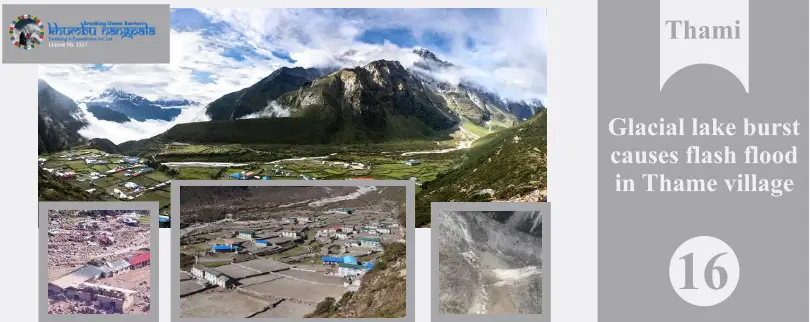Glacial lake burst causes flash flood in Thame village, sparks climate change concerns
Posted in: 18th Aug, 2024 Post Category: Blog Blog of Nepal
KATHMANDU, AUGUST 16
The devastating flash flood and mudslide that overwhelmed Thame village in Khumbu Pasang Lhamu Rural Municipality-5 on Friday afternoon has been confirmed to be the result of a glacial lake outburst.
A team of experts and authorities had been dispatched to inspect and monitor the disaster site and investigate the cause of the sudden flood and mudslide that struck the village.
Following an aerial inspection on Saturday morning, the Khumbu Pasang Lhamu Rural Municipality confirmed that the flood was triggered by the outburst of a glacial lake, one of the many lakes situated above the valley. The municipality has also said that there is no further risk of flash floods or mudslides from this particular outburst.
In response to the disaster, a Nepali Army team was deployed to the site, rescuing several villagers. Police personnel have also arrived at the scene to initiate rescue and rehabilitation operations.
The Minister for Defence, Man Bir Rai, along with federal and provincial assembly members, rural municipality chairs, and the Chief District Officer of Solukhumbu, had reached Thame village on Saturday morning for an on-site inspection of the flood-affected areas.
On Friday several attempts to fly helicopters from Kathmandu, Itahari and Phaplu Airport for rescue operation and inspection of the flood-affected areas had failed due to the adverse weather.The sudden flood on Friday afternoon caused significant damage, affecting nearly half of the village.
Thame village, home to 45 households, is renowned for its association with legendary climbers, including Tenzing Norgay Sherpa, Apa Sherpa, Kami Rita Sherpa, and Lakpa Rita Sherpa. Fortunately, as the incident occurred during the day and not at night, there were no human casualties. Due to the off-season for tourism, there were very few people in the village, and they managed to flee to higher ground.
Authorities reported that around 93 villagers who fled to higher altitudes or were rescued are now being sheltered in an army camp, while 42 others have been temporarily placed in a nearby community building. Police have stated that a school, a health clinic, and 15 houses have been completely damaged by the flood.
Monetary assistance of Rs 50,000 has been provided to each of the 15 households whose homes were completely destroyed, with Rs 15,000 per household by the rural municipality and the District Disaster Rescue Committee. Additionally, Rs 10,000 has been given to 31 households partially affected by the flood, with further relief to be distributed as more affected households are identified and categorized, the rural municipality added.
Although the water level in the Thame River has decreased, it continues to pose a threat to settlements along its banks in the Khumbu and lower Solu areas. The local power project’s powerhouse was completely damaged, and 200 meters of the trekking route from Phakding to Namche, specifically in the Jame area, has been washed away. Additionally, the Mapya-Khumbu Friendship Bridge over the Dudhkoshi River, connecting Khumbu Pasang Lhamu Rural Municipality and Mapyadudhkoshi Rural Municipality, was damaged by the floods, forcing authorities to relocate five families in Mapyadudhkoshi Rural Municipality-6 to a safer location. The direct road network from Salleri to Khumbu has been disrupted.The flood has also hindered movement to areas above Namche in Solukhumbu, cutting off the tourist route from Phakding to Namche and access to the Everest region.
Former Prime Minister Pushpa Kamal Dahal ‘Prachanda’ urged the government to spare no efforts in rescue and relief operations, emphasizing the vulnerability of mountain communities to climate change. Taking to social media, Dahal said that Human lives in mountainous regions are increasingly vulnerable due to the severe impacts of climate change.
“Natural calamities, such as landslides & floods, along with the continuous melting of mountains & glaciers, pose perennial threats to our communities & natural resources.” “We are facing consequences for a problem for which we are not responsible. I have strongly raised this issue at the UNGA and COP28, calling for climate justice. The recent GLOFs in Thame in the Everest region, have caused significant damage and put lives at risk,” Dahal added.
“I urge the government to provide swift relief to those affected and call on the international community to increase support to protect Nepal from climate-related risks.”
Experts from the International Centre for Integrated Mountain Development (ICIMOD) have raised concerns about the irreversible changes occurring in the glaciers, snow, and permafrost in the Himalayan region.
According to the International Centre for Integrated Mountain Development (ICIMOD), several glacial lakes lie upstream of Thame. Satellite images of the area dating back to 2017 obtained by ICIMOD from the European Space Agency’s Copernicus earth observation programme show these lakes constantly changing in size. Researchers at ICIMOD confirm that some of them frequently expand and contract, making them susceptible to breaches.
These lakes lie near the popular trekking destination of Tashi Lapcha Pass. The neighbouring valley holds one of the region’s most potentially dangerous glacial lakes, Tsho Rolpa, ICIMOD added.
It warns floods and landslides are projected to increase, with climate the key driver in many of the water- and cryosphere-related disasters already recorded in recent years, through meltwater, larger and more potentially dangerous lakes, unstable slopes from thawing permafrost, and increasing sediment loads in rivers.
The Solukhumbu District Administration Office later confirmed that the flood in Thame was caused by the outburst of two glacial lakes among the five located above the area. The office added that while one of the remaining lakes is safe, the other two are still at risk of bursting.
Similarly, the Department of Hydrology and Meteorology attributed the glacial lake outburst in Thame to climate change and rising temperatures. According to the department, the daily average temperature in the Thame area began increasing on August 9, rising from 9.7 degrees Celsius to 11 degrees Celsius. On the day of the flood, the temperature spiked to 15 degrees Celsius. The department explained that the outburst was triggered by this temperature rise combined with continuous rainfall. Tenzing Chogyal Sherpa, ICIMOD Cryosphere Analyst and founder of the #SaveOurSnow campaign, is from the Solukhumbu region where the floods hit. “This flood swept away parts of a village I know intimately well, where friends, neighbours and relatives live, with ancestral ties going back generations,” he said. “It is a painfully personal reminder of the devastating impacts of temperature rise on mountain communities. Millions of people in the mountains have contributed literally nothing to greenhouse gas emissions, but face the catastrophic impacts of these emissions with ever-increasing frequency and severity.
“Climate change is a crime scene. The glaciers are making it visible. We cannot look the other way,” said Miriam Jackson, Cryosphere lead for ICIMOD.









